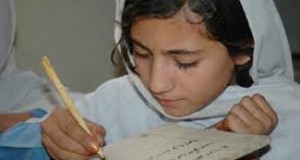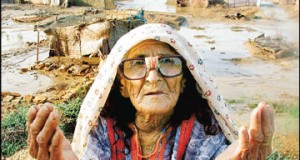When the Pakistan state looks at Balochistan–from Islamabad, or Raiwind, or  Lahore, or from the commercial capital, Karachi–it assumes it has the right to decide how events in the country’s largest province ought to be interpreted. Certainly, it has had the power to silence the Baloch in the mainstream national conversation. Sometimes, the muffling of Baloch voices is deliberate: last, the offices of the Balochi newspaper, Daily Tawar, was ransacked and burned, allegedly by the Inter-Services Intelligence (ISI). At other times, it is unintentional. Most observers and pundits sitting at the center in Islamabad take little time in understanding the province.
Lahore, or from the commercial capital, Karachi–it assumes it has the right to decide how events in the country’s largest province ought to be interpreted. Certainly, it has had the power to silence the Baloch in the mainstream national conversation. Sometimes, the muffling of Baloch voices is deliberate: last, the offices of the Balochi newspaper, Daily Tawar, was ransacked and burned, allegedly by the Inter-Services Intelligence (ISI). At other times, it is unintentional. Most observers and pundits sitting at the center in Islamabad take little time in understanding the province.
The failure to accurately understand the conditions in Balochistan was reflected in the pronouncements by commentators and activists last week as they lamented attacks carried out by the Lashkar-e-Jhangvi (LeJ) and the Balochistan Liberation Army (BLA) in a way that appeared to treat both events as equal.
They are not.
On June 15, 2013, there were three attacks in Balochistan, Pakistan’s most resource rich, but sparsely populated, province. In the early hours of that morning, BLA separatists attacked a residence once used by Pakistan’s founder, Muhammad Ali Jinnah. Jinnah’s residency is featured on Pakistan’s 100 rupee notes, and is seen as a symbol of Pakistani nationalism in Balochistan. The attack left one police officer dead, and took place in Ziarat, 3 hours outside of the province’s capital, Quetta.
Later that day, the LeJ, a Sunni sectarian organization, carried out two separate attacks. A female suicide bomber mounted a university bus carrying explosives, killing 15 students, most of them women. They followed up the attack on the bus with an offensive against a hospital complex where the wounded had been taken. When it was over, 25 were dead.
It was the attack on a historical site, however, far more than the killing of the police officer at that location, or the targeted attacks on students and the wounded that drew the attention of Pakistani politicians. Pakistan’s Interior Minister Chaudhry Nisar Ali Khan, and Information Minister Pervaiz Rasheed, decided to skip the funerals of these victims, instead choosing to visit Ziarat. The integrity of this quintessential symbol of Pakistani nationalism seemed to be their highest priority.
At a press conference on the attacks held by the Pakistan Muslim League-Nawaz (PML-N) after the attacks, Pakistan’s ruling party failed to mention the LeJ, or the police officer killed at Ziarat. Social media feeds swelled with laments mourning the loss of the Quaid’s, or Jinnah’s, residency, at least in equal measure as, if not more than, they mourned those who lost their lives. The attack on the residency already has a Wikipedia page with far more detail—including domestic and foreign responses—than the shorter page dedicated to the attack on the students and patients of Quetta.
And, when Interior Minister Nisar appeared on the parliament floor, he insisted that a newly-formed Joint Investigation Team (JIT) probe both attacks—as if an attack on a building were the same as the loss of 25 lives.
***
The PML-N’s coalition partner in the National Assembly, the Pakhtunkhwa Milli Awami Party (PkMAP), has been refreshingly critical of Nisar’s decision to equate the BLA and LeJ attacks. Unlike the National Party, which called a strike to mourn both attacks, the PkMAP’s secretary general, Akram Shah, pointed out that the residency was a “symbol of slavery.” Originally built by Sir Robert Groves Sandeman, the colonial British officer who ruled Balochistan until his death in 1892, the residency “reminded the Baloch and Pashtuns of the long period when they were slaves of [the] British empire.” Sandeman successfully established a colonial policy that turned the Khan of Kalat and Baloch sardars into agents of the British crown, in exchange for an allowance that covered their personal expenses. That policy persisted long after the creation of Pakistan. Balochistan did not become a full-fledged province until 1970, and the legal loophole that allows sardars to maintain a personal police force, the Levies, can be traced back to Sandeman himself.
Shah made bold remarks. But, there is a more complex issue at hand than Ziarat’s historical lineage.
To understand Balochistan and properly analyze the violence of these attacks, we must turn to the larger context of violence and counter-violence in the province. And, we must acknowledge that when it comes to exercising force, the state is just as bad as the militant organizations that we love to hate.
***
In Balochistan, Jinnah is seen as a man who ordered the Pakistan Army to annex Balochistan and force it to join Pakistan in 1948. The forcible inclusion of Balochistan in Pakistan ran counter to Baloch wishes: only a group of British-appointed tribal sardars in Balochistan’s northern Pashtun belt agreed to join Pakistan in a July 1947 conference, where neither the Khan of Kalat—then the ruler of the Kalat state in present-day Balochistan—nor its sardars were included. The only body, similar to a representative assembly was the two-chamber Kalat Assembly. It declared that Kalat did not want to join the new state. Only 29-years-old, Ghaus Bux Bizenjo, the father of the National Party (NP) leader, Hasil Khan Bizenjo, clarified.
“I do not propose to create hurdles for the newly created state in matters of defense, external affairs and communications. But we want an honorable relationship and not a humiliating one. We don’t want to amalgamate with Pakistan.”
The Baloch narrative does not end here.
In fact, the current Baloch uprising is the fifth in Pakistan’s history. This is not the first time that the Pakistani state has signaled an interest in negotiations. The Pakistan Army has, several times, promised safe passage to Baloch rebels in exchange for peace negotiations. Instead of living up to their word, however, our state’s security forces arrested and hanged Baloch rebels. One of the more circulated stories is that of 90-year old Nawab Nouroze Khan Zarakzai, the chief of the Zehri tribe, who led a strong guerilla force of 750 to 1000 men. According to the Baloch, the army had promised the abolition of the One Unit Plan, a return of the Khan of Kalat (whom they had arrested), and amnesty to the guerillas. But, when Nouroze Khan returned with his men, they were arrested and his son and five others were hanged on treason charges. The Baloch still memorialize the date of their hanging on July 15th every year. They call it Martyr’s Day.
Two years after losing East Pakistan—now Bangladesh—then Prime Minister Zulfiqar Ali Bhutto was set F-14 fighter jets with Irani pilots by the Shah of Iran, Muhammad Reza Shah Pehlavi, to carry out operations in Balochistan. One brigadier, who took part in the 1973 operation in Balochistan, told me that his unit “sprayed bullets on a village to pacify the residents. We never got any trouble from them after that,” the brigadier grinned.
Bhutto also dismissed the democratically elected National Awami Party (NAP) government in Balochistan on charges of treason. Some of Balochistan’s most influential leaders, including Ghaus Bux Bizenjo, Nawab Khair Bakhsh Marri, Sardar Attaullah Mengal, and Sher Muhammad Marri were tried in the Hyderabad Conspiracy Trial, which lasted from 1975 to 1979.
Today, the Pakistan Army is the primary suspect in the hundreds of tortured and mutilated bodies that have turned up in Balochistan.
This is why the commander of the Balochistan Liberation Front (BLF), Dr. Allah Nazar, has said he appreciates dialogue, but only under the supervision of the United Nations. “Otherwise, we are not going to sit with the state on the negotiation table,” says Dr. Nazar. The BLF had earlier demanded that Pakistan ensure the safe passage of international observers across the province for the May 11 elections. Their demands beg the question: Why are rebel groups more willing to trust international organizations than the Pakistani state?
In the last few weeks almost everyone—from Pakistan’s politicians to its media organizations, and its liberal activists to its political analysts—has celebrated the coming of a new democratic dawn in Balochistan. The rise of PkMAP’s Mehmood Khan Achakzai as Balochistan’s governor, and the National Party’s (NP) Dr. Abdul Malik Baloch as its chief minister, is a significant and important step forward in the way that the center has dealt with Balochistan.
Yet, the new face of the provincial government’s leaders has more to do with a shift in establishment policy than a genuine change in the situation on the ground. Although the reports are difficult to verify, up to 49 Baloch have either gone missing or turned up dead since the May 11 elections. The Pakistan media has been unwilling to accurately report on this issue in the fear that it might undermine Balochistan’s newest crop of politicians—a group, of which Pakistan’s liberal elite is particularly fond.
This is particularly disconcerting given the reality of voter turnout in Balochistan in the 2013 elections. While Pashtuns in Balochistan turned out in record numbers in Quetta and the northern belt, the Baloch basically “did not vote” according to Malik Siraj Akbar, the editor of The Baloch Hal. Of the 14 provincial assembly seats that were being contested in southern Balochistan—home to the new chief minister as well as the middle-class uprising led by the Balochistan Liberation Front (BLF)—only four constituencies saw an increase in voter turnouts, bringing voter turnout numbers back to 1997 levels. One constituency went from a 43 per cent voter turnout in 2008, to a 1 per cent voter turnout in 2013. In Chief Minister Malik Baloch’s own constituency, only 12 per cent turned out to vote, an almost 30 per cent drop from the 2008 elections, when the entire crop of nationalist parties, from the NP to the Balochistan National Party-Mengal (BNP-M) and the PkMAP, had boycotted the elections. If we look at numbers from the 1988 elections onwards, this is the highest drop in voter turnout southern Balochistan has ever seen.
Separatists say that the voter turnout was a direct result of their call for a complete shutter-down strike and boycott of the May 11 election. Dr. Abdul Malik Baloch says that voters felt threatened, and were too afraid to show up and cast their ballot. And, some policy analysts say that the main reason for low turnouts was simple logistics: polling booths are few and far between in the vast expanse of the Balochistan province.
Whatever the real reason is, however, it is fundamentally irrelevant. What is relevant is that the voter turnout numbers among the Baloch reveal the vast gap between the people that we claim are represented by politicians in Quetta, and the new leadership in the provincial government. The fact is that the Pakistani media, politicians and activists choose to ignore clear-cut statistics, that they fail to draw obvious links between what these numbers mean for Quetta and that they continue to turn a blind eye to the dumping of mutilated-beyond-recognition bodies.
For many observers, politics only exists within the confines of the nation state. As a result, only those who have a place in provincial assemblies or the parliament in Islamabad are considered legitimate representatives,. Anyone who falls outside these limits is ignored. Pakistan’s mainstream pundits have become so used to mimicking the language of the state that they either forget to include voices from beyond the halls of parliament, or deliberately fail to do so because they are afraid that bringing them into the conversation will undermine the integrity of Pakistani nationalism.
***
Neither of these attacks occurred simply as external forces outside of the state.
Army cantonments occupy around half the city’s territory, according to a source from the Frontier Corps (FC). Twenty-seven platoons, or almost 1000 soldiers, from the paramilitary force patrolled the streets alongside the police in 2012. It is near impossible to drive more than 10 minutes before being stopped by a boy in khaki asking for identification; yet, several attacks on the Hazara community have taken place less than 100 meters away from checkpoints, according to Asmatullah Niaz, the chairman of the Hazara Student Federation (HSF).
There are only two possible explanations: either the security forces are incapable or complicit. Interior Minister Nisar himself, seemed to hint at the latter when he recently asked how “Quetta could be the repeated victim of terrorist attacks with police, FC, security and intelligence agencies on every corner.”
Niaz says that the security establishment allows militant groups to operate with impunity because it helps divert attention from the widespread separatist uprising that has taken hold among the Baloch. The security establishment sees the LeJ as a strategic asset in an area close to the Afghan border as NATO troops plan to step down their presence next year. According to Ayesha Siddiqa, a leading security analyst, the LeJ and other militant groups were raised during the 1980s and integrated in the security agencies tactical planning as they pursued a policy of resisting India. “These jihadis will disappear the day their creators run out of uses for them,” says Siddiqa.
So, the state is complicit in a form of violence aimed at creating sectarian divisions as spectacles at the expense of Pakistanis. In context and ideology, the BLA attack differs from the LeJ attack. The attack on Jinnah’s residency is the expression of a subjugated people rather than an attack by an asset of the state.
The BLA issued a press release following its exploit that has received scant or no attention in the Pakistani press. That press release called on “their Pashtun brothers to build a monument in tribute to Khan Abdul Ghaffar Khan and Abdul Samad Achakzai.” Both Pashtun stalwarts are significant figures in the history of progressive Pakistan. With all of their faults and limitations, these two men are seen as the forefathers of two of Pakistan’s most secular and progressive political parties: the Awami National Party (ANP) and the PkMAP. By highlighting them, the BLA underlines a broadly left, secular and importantly anti-colonial history—one with which they associate today. Indeed, the BLA spokesman followed up with a statement that declared that the BLA can only think of negotiations after destroying “the symbols of invaders on Baloch land and regained our national geography and national identity.”
The attack on the Ziarat residency, where the BLA replaced the Pakistani flag with their own, is an indirect invitation directed at us: ‘See Pakistan from our eyes.’ Any negotiation that wishes to be long-lasting needs to do just that: Seeing the history of the state within Balochistan. Indeed, that is what the Baloch recall whenever the Pakistani state approaches the Baloch and its rebels. Even those nationalist leaders that are favorites of Islamabad, like Dr, Abdul Malik Baloch, Akhtar Mengal and Mehmood Khan Achakzai, were raised with narratives of betrayal. The political response that the NP, PkMAP and the BNP-M choose to express might be vastly different from those of the rebels. But most Baloch are well-acquainted with tales of a Pakistan that goes against its own word, and continues to ignore the materiality of the corpses that pile up: parents burying their sons; sisters burying their brothers, and babies made fatherless.
To equate the LeJ and BLA attacks is to see through the eyes of the Pakistani state rather than those it subjugates. When lives are at stake, we must turn that lens back where it belongs: on the state. (Courtesy: Tanqeed)
Mahvish Ahmad is a journalist and lecturer in political science, and the co-founder of Tanqeed. A shorter version of this article was originally published in The News on Sunday (TNS). The parts that do not appear in TNS are not a result of their editorial policy, but because the writer added, and edited, the article after print.
 Balochistan Point Voice of Nation
Balochistan Point Voice of Nation




